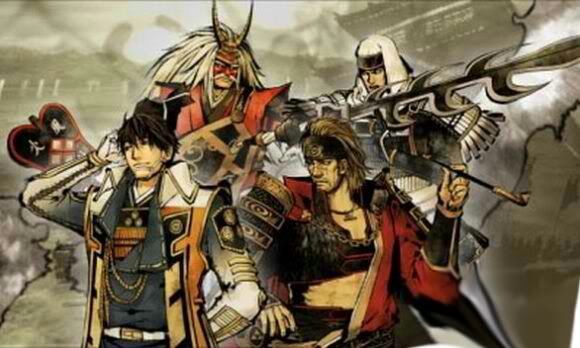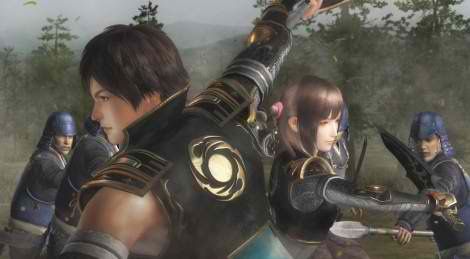
The Warriors games often get a bad rap for a number of reasons- the gameplay is the same from one game to the next; the combo system is too simple; the voice acting is just bad, etc. But for the purposes of this review, let's take a look at the game- how it plays and what it accomplishes- rather than the technical aspects- complexity of the fighting system or how many grunt enemy textures there are- and judge it on the merits of the final product.
The campaign is divided into 4 acts- comprised of 7-9 battles each(not to mention the final act also gives you the option of fighting the battles for either side)- plus a fifth act: Gaiden, which contains a few extra battles outside the actual campaign storyline, and will be where you will find the additional battles downloaded via spotpass.
This is my first Warriors game, and while it was confusing at first, what with all the Japanese character names and regions and alliances(it was a real hassle at first trying to figure out who was related to whom and which regions were at war with which), but by the time I was halfway through the second act, I could tell my Kanetsugus from my Kagetsunas and my warlord from their lowly retainers no problem.
The entirety of the game's dialogue, from the narrator explaining the history of each battle beforehand to the officers shouting directions on the battlefield to the debriefing from your warlord in the aftermath, is all voice acted in Japanese. The downside, of course, being the necessity of reading the translations rather than giving your full attention to what's going on on screen, but I think that balances nicely with not having to listen to the seemingly unavoidably bad voice acting that occurs when western actors try to imitate the natural... enthusiasm... that the Japanese often bring to their acting.

On the battlefield, your hero(male or female, and with a name of your choosing), along with whichever playable characters accompany him/her, will shred the enemy ranks and eventually take a crack at the enemy commander. When the enemies get thick on the ground, the hardware can have a hard time keeping up- it is a launch title, after all, and the devs haven't got the experience yet to squeeze the most out of the hardware- so enemies can occasionally pop in right in front of you, or even all around you if the area is especially crowded.
The combo system, which critics often claim is merely button mashing, is much more deep than it gets credit for- yes, there are only two attack buttons(for fast strikes or powerful finishers), but as you play and reach higher levels, you become familiar with how many quick strikes before the finisher will get what kind of combo. Then you start to figure out which finishers are best for what situations and before you know it, you're a god on the battlefield and only the most powerful among the enemy will be able to stand against you for long. Add to that the Musou attack, which(after filling the musou gauge by cutting down the enemy) slows down time and maximizes your destruction potential for a short time, and the spirit gauge, which allows your playable generals to loose special abilities on the battlefield from healing one playable character to raising the movement speed of all allied units on the battlefield and more. Get the hang of these three assets; Combo, Musou and Spirit, and you'll be unstoppable in no time.
In the midst of the battle, objectives will arise- unless specifically noted, these missions are generally optional, though the outcome of the objectives will have an impact on the battlefield itself; if you fail to prevent an enemy officer from infiltrating an allied fortress, for instance, it may cause a drop in allied morale, which will cause a drop in allied units' health and attack power, or maybe it would cause enemy reinforcements to appear within the fortress to launch a counter attack. Given the size of the battlefields, it would be impossible for one hero to manage all of these tasks at once, so Samurai Warriors Chronicles gives you up to four characters to command at once, and by spreading your generals across the battlefield you increase the odds of having a character in place to complete an objective in a timely fashion. Directing the three characters you're currently not playing as is simple, but generally effective- you only have two commands: "move here" or "attack this officer." Both of the commands are issued my opening the map, selecting the character you want to execute the order, and placing a waypoint on the map. If the waypoint is devoid of enemy officers, the character will move there, if there is an officer there, the character will engage the enemy in combat. Just be careful with objectives that involve preventing an enemy from reaching an area, as the friendly AI isn't so good at stopping an enemy that isn't interested in fighting. Luckily, with a tap of the touch screen you can switch to your general as he reaches the intercept point to crush the would-be infiltrator yourself.
The lack of depth in the command system was a tad disappointing, as I would have liked a little more specific directions, like, "defend this area/officer," or, "attack this area/base/enemy." Or at least have the ability to direct non-playable allied officers.
There are a few cutscenes when you begin or complete major historical events. These cutscenes are full 3D and they look great for it. Once experienced in the campaign, these cutscenes are stored in the Vault section of the main menu and can be replayed whenever you like.
The game also features a dynamic friendship system- when you win a battle or assist a character calling for help, the opinion of you held by the other playable characters on your side of the battlefield increases, as well as through after action events where your hero seeks out the other characters to chat with. As you learn more about the personalities of the other characters in the game you can pick out the appropriate responses to their statements or questions to either raise or lower your friendship level with that individual. For instance, I came across one character who would get impatient when I would pick the agreeable or reverential response, and another who told me to get lost when my response wasn't sufficiently deferential in his opinion.
There are a few reasons to get in good with as many characters as you can- attaining the first friendship level makes the character available in character select for replaying missions you've already completed. Attaining the last friendship level allows you to purchase that character's weapon/fighting style from the in game shop, and various missions in act 4 become available depending on your friendship level with certain key characters and other criteria.
The shop is more like a forging area than an actual shop- the only thing shoplike about it is that they sell horses, fighting styles unlocked from the friending system, and clothing/armor(cosmetic only) and they'll buy whatever stuff you want to sell them. Beyond that, the main focus of the shop is to upgrade the weapons your characters collect on the battlefield by fusing them with other weapons(to increase stat values- ATK, DEF, AGL, etc) or items(to add elemental effects or stat bonuses). The shop will also buy your play coins at a rate of 100 gold pieces per coin. It isn't really much, but I have yet to find a better use for them.
On the whole, aside from some small design missteps, I think the game has a lot of depth that goes unrecognized and unappreciated by most, but I for one am proud to have such an empowering game in my library- after all, when was the last time you played a game that made you feel like the fist of an angry god?
No comments:
Post a Comment